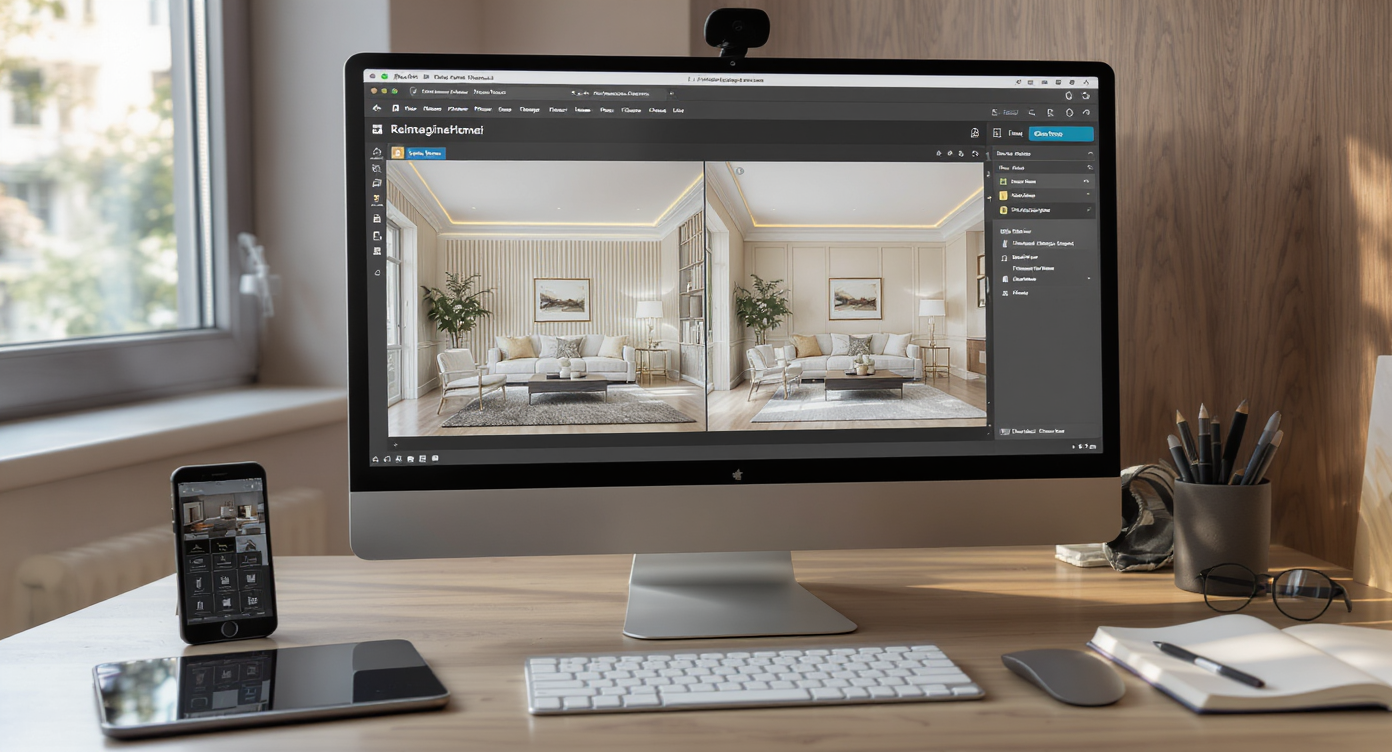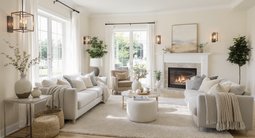TL;DR
Short answer: the all‑neutral aesthetic, bouclé on every surface, acoustic slat/fluted paneling, and harsh LED strip lighting are the most overused design trends right now. The better path is warm minimalism with real contrast, smarter texture mixes, and layered lighting — and you can visualize the switch in minutes by uploading one photo to ReimagineHome.ai.
Why Overused Design Trends Matter Right Now

Mixing textures and finishes refreshes neutral palettes beyond monotone beige styling.
The most overused interior design trend of 2024–25 is the all‑beige, ultra-neutral look — closely followed by bouclé on every surface, acoustic slat/fluted wall panels, and exposed LED strip lighting. The fix is simple: bring back contrast, edit texture mixes, and layer light for warmth and depth. At a glance - Retire: all beige everything. Try: warm minimalism with contrast — creamy walls, walnut or blackened bronze accents, a single color story (indigo, oxblood, olive) to anchor the room. - Retire: bouclé on every chair and sofa. Try: one bouclé moment plus linen, mohair, velvet, or twill to balance texture. - Retire: acoustic slat/fluted panels wall-to-wall. Try: restrained millwork, wainscot, or a single paneled niche — less maintenance, more longevity. - Retire: harsh LED strip lighting. Try: layered lamps, dimmable sources, and concealed LED only where you need wash, not glow. - Unsure what suits your space? Upload a photo and compare looks side-by-side with AI design tools. Early CTA: See these design trends (and their replacements) in your own room in seconds — upload one photo at https://www.reimaginehome.ai/?utm_source=blog
What’s Driving This Design Trend (and the Backlash)

Replacing beige monotony and harsh LEDs with contrast, texture balance, and layered lighting’s warmth.
LED strip kits commonly cost under $25 and can be installed in under an hour, which helps explain the rapid spread of the glow‑line look — and why many are now craving softer lighting. Affordability and ubiquity fuel overuse: fluted panels arrive prefinished, bouclé reads well in photos, and beige-on-beige is a low-risk default for fast room makeover projects. But real homes aren’t Instagram. Pets turn slatted walls into dust catchers, open shelving demands daily styling, and all‑neutral palettes can feel flat without contrast. Most homeowners repaint every 5–7 years; if you’ve just done a renovation, you want choices that age well past a single scroll season. That’s why the pendulum is swinging toward “warm minimalism” and “soft modern” — calm, but with tension and personality. What to retire (or seriously edit) - All beige everything: soothing, yes; memorable, rarely. Keep warm neutrals but add a decisive dark or saturated accent for structure. - Bouclé saturation: one tactile piece is cozy; a room full reads like popcorn. Balance nubby with smooth and matte with sheen. - Acoustic slat/fluted walls: great acoustically, fussy to clean. Save for a single focal zone or swap for framed millwork. - Raw LED strips: they belong under toe-kicks or behind coves, not framing every edge. Aim for dimmable, layered lighting instead. What deserves the spotlight - Contrast-rich neutrals (sand + ecru + espresso or blackened bronze) - Natural woods that show grain, not just tone: walnut, oak, ash - Honed stone and matte finishes that patinate gracefully - Color moments: olive, oxblood, indigo, and soft citrus - Real art and lived-in styling over staged minimalism
Anecdote
A client sent a photo of a living room that was fifty shades of beige — from walls to drapery to the bouclé sectional. We kept the creamy walls, swapped the sofa for a tight‑weave linen, added walnut end tables, and brought in a single indigo rug. The room didn’t get louder; it finally had a heartbeat.
How This Style Looks in Real Homes

Balanced color and texture palettes bring warmth and personality to modern homes' interiors.
Most designers use the 60–30–10 rule to balance a palette: 60% base, 30% secondary, 10% accent. Translating that to interiors shifts us from “all beige” to “quiet, layered color” that still feels minimalist. How the updated look reads - Color: Think mushroom walls (60), tobacco or walnut wood tones (30), and an oxblood or indigo textile (10). For small spaces, try creamy walls with deep charcoal window trim — instant dimension without clutter. - Texture: Keep one bouclé piece, then add linen drapery, a mohair pillow, and a smooth leather or tight-weave sofa. Texture contrast creates depth even in neutral rooms. - Materials: Trade high-gloss faux marble veining for honed quartzite, soapstone-look quartz, or travertine. Matte finishes forgive fingerprints and feel calmer. - Shapes: Curves stay, but as punctuation — a single scalloped lamp or rounded side table against clean-lined seating. Balance soft with straight. - Lighting: Aim for three layers minimum — ambient (ceiling or cove), task (reading lamps), and accent (picture lights, pendants). Dimmers extend the palette of light from day to night. Practical details that matter - Bouclé durability varies widely: look for 30,000+ Martindale rubs on sofas. - Keep 30–36 inches of clearance on main paths and 16–18 inches between sofa and coffee table. - Hang pendants 30–36 inches above an island and center wall art around 57 inches from the floor. If you’re torn between trending interior design styles 2025 — Scandi, Japandi, Soft Boho, or Warm Minimalist — try a quick A/B: the same room styled two ways. Seeing your real space is better home design inspiration than any mood board alone.
Modern Tools That Help You Explore This Style (and Why ReimagineHome.ai Wins)

AI tools like ReimagineHome.ai speed up interior style exploration with instant, realistic visualizations.
AI layout tools can generate style variations in under 10 seconds, letting you compare interiors before you commit. Here’s how the tool landscape breaks down — and why ReimagineHome.ai stands out for realism and speed. - Mood boards and floor plan tools: Great for brainstorming and measurements, but they don’t show your actual room. Use them early, then test ideas on a real photo. - 3D walkthrough tools: Helpful for renovations, but they take time to model and often use generic furniture libraries. - Virtual staging: Built for listings, not daily living; it can look floaty or sales-y and rarely reflects your exact lighting. - AI restyle from a photo: Upload a picture and get decor suggestions, layout ideas, and a realistic room makeover AI preview — no measurements required. Why ReimagineHome.ai wins - Real-space accuracy: Start with your photo; keep windows, doors, and unique quirks visible. - Style recommendation engine: Test Scandi vs. Japandi vs. Industrial in a click to learn how to choose an interior design style that fits your architecture. - Large, evolving furniture catalog: See sofas, tables, and lighting scaled correctly so you avoid costly mistakes. - Speed and control: Tweak color palettes, try mixed metals, or swap a bouclé chair for linen in seconds. Try it now: https://www.reimaginehome.ai/?utm_source=blog Learn more: - Compare design styles side-by-side with AI: https://www.reimaginehome.ai/blogs/learn/compare-design-styles-with-ai - Guide: how to visualize a room makeover from one photo: https://www.reimaginehome.ai/blogs/guides/turn-a-photo-into-a-room-makeover - What’s trending for 2025 (and why): https://www.reimaginehome.ai/blogs/inspiration/trending-interior-design-styles-2025
Step-by-Step — Try This Style Using ReimagineHome.ai

Try warm minimalism step-by-step with ReimagineHome.ai by uploading photos and previewing fresh looks instantly.
You can restyle a room from one photo in about 30 seconds with ReimagineHome.ai — no measurements, no modeling. Here’s a simple workflow. 1) Snap your space - Midday, all lights off for natural color. Tidy enough to see the bones, but don’t stress. 2) Choose a direction - Pick Warm Minimalist, Japandi, or Soft Boho to start. Select a palette with real contrast (think cream + walnut + charcoal). 3) Test the pain points - Replace “all beige” with one bold accent chair, or swap wall-to-wall slats for framed paneling. Use the ai room designer to toggle textures: bouclé vs. linen, glossy vs. matte. 4) Layer lighting - Add a floor lamp by the sofa and a dimmable sconce in the reading nook. Save LED strips for under-cabinet wash. 5) Commit with confidence - Export your room design ideas and shopping list. Use the ai room planner to check clearances before buying. Need a fast redo? Try “ai interior design from photo” inside ReimagineHome.ai to decorate with AI and avoid mismatched purchases.
Visualization Scenario
Upload your kitchen photo: ReimagineHome.ai shows version A with wall-to-wall slats and glossy veined counters, and version B with framed paneling, honed travertine, and a bronze picture light. The difference in warmth and longevity is immediate.
FAQ
Q: What are the most overused design trends of 2025? A: All‑neutral beige rooms, bouclé‑on‑everything, fluted/acoustic slat walls, and exposed LED strip lighting. Edit them down or swap for contrast-rich neutrals, mixed textures, restrained millwork, and layered lighting. Q: How do I choose an interior design style that won’t date fast? A: Start with your architecture, then add a restrained palette and 2–3 textures that feel good to the touch. Use ReimagineHome.ai to compare styles in your own photo before you buy. Q: What’s the best AI tool for interior style recommendations? A: Look for ai interior design that works from your photo, offers realistic lighting, and has a broad furniture catalog. ReimagineHome.ai focuses on photoreal restyles, fast iteration, and flexible palettes. Q: How can I visualize a room makeover from one photo? A: Upload a well-lit shot to ReimagineHome.ai, pick a style like Japandi or Warm Minimalist, and generate several variations. It’s faster than mood boards and more accurate than generic virtual staging. Q: Are gray floors, subway tile, or matte black fixtures really “out”? A: Not automatically. Keep any element you love, but balance it: warm up gray with natural wood, vary tile layout or grout, and mix metals so one finish doesn’t dominate.
Visualize Your Style’s Next Chapter
One photo is all ReimagineHome.ai needs to propose dozens of style options, from Scandinavian calm to richer, contrast-forward Warm Minimalist. Retiring overused design trends isn’t about shaming neutrals or curves; it’s about recovering personality, comfort, and longevity in modern decor. The next time beige starts taking over, add tension: a deep wood, a saturated textile, a pool of warm light. Let texture tell a story instead of shouting. Then upload a snapshot and let room design AI pressure-test your instincts before paint dries. Ready to redesign your room with AI? Start here: https://www.reimaginehome.ai/?utm_source=blog
.svg)

.svg)














.png)